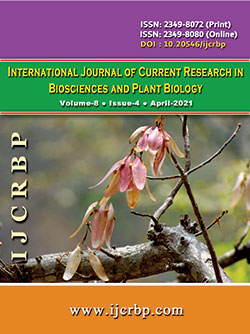 |
Online ISSN : 2349-8080 Issues : 12 per year Publisher : Excellent Publishers Email : editorinchiefijcrbp@gmail.com |
No. 356, Col. Libertad. C.P. 87019, Ciudad Victoria, Tamaulipas, México.
2CONACyT - Departamento de Agricultura, Sociedad y Ambiente, El Colegio de la Frontera
Sur. Carretera a Reforma Km. 15.5 S/N, Ranchería Guineo 2a. Sección, 86280, Villahermosa,
Centro, Tabasco, México.
3Unidad de Biotecnología, Centro de Investigación Científica de Yucatán A.C. Calle 43 No. 130,
Col. Chuburná de Hidalgo, 97200 Mérida, Yucatán, México.
4Unidad de Recursos Naturales, Centro de Investigación Científica de Yucatán A.C.
In vitro studies of plant-pathogen interactions using leaf-fragments remains controversial compared to those studies under field conditions. The leaf-fragments technique, which predominantly uses benzimidazole in the culture medium to retard senescence, has been reported as reliable, fast, and inexpensive for analysis of aggressiveness and resistance in the Mycosphaerella fijiensis-Musa spp. interaction. However, no data have been published verifying whether in vitro banana leaf fragments maintain photosynthetic activity, which is a requirement for studying this interaction. In this study, maximum quantum efficiency of photosystem II, electron transport rate, transpiration, carbon dioxide exchange, light saturation point, and stomatal density were evaluated in in vitro leaf fragments of the Grand Nain banana genotype. Furthermore, the same parameters were also attained for leaves from plants in the field (during two seasons) and greenhouse conditions. The photosynthetic yield was constant during the experiment in leaf fragments with benzimidazole, and the photosynthetic rates on day 30 were similar throughout the whole experiment. This study supports that the banana-leaf-fragment technique as such protects the photosynthetic apparatus and then is suitable for studies on interactions such as that of M. fijiensis-Musa acuminata.
